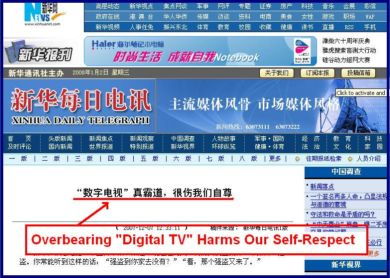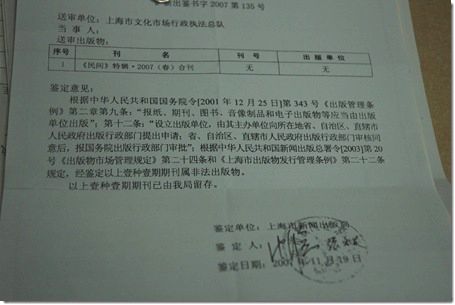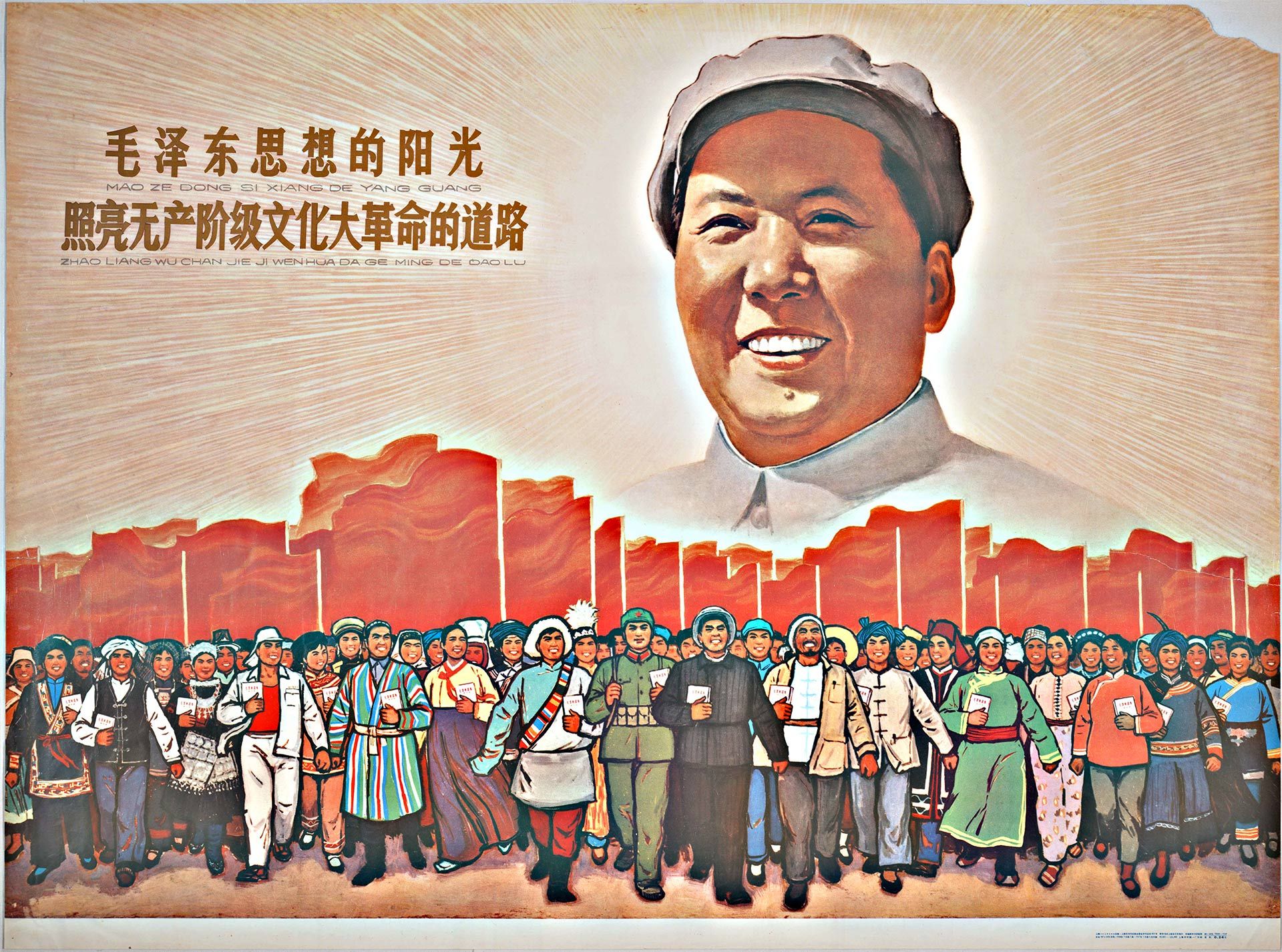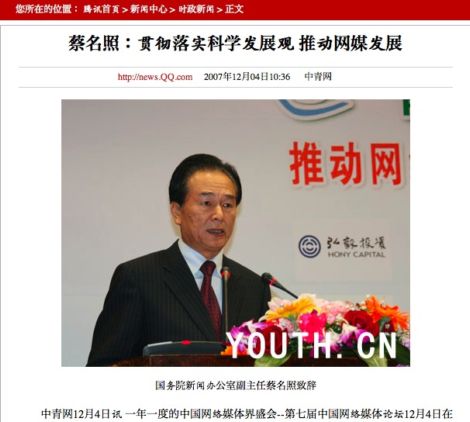Media silenced over the "thieves" of China's digital TV rollout
By David Bandurski – While business headlines have been bullish on China’s digital television, or DTV, market in recent months, there are some indications consumers have been arm-twisted into making the switch, and many are unhappy about poor quality, insufficient choice and higher costs. But the message is out from China’s propaganda czars: DTV conversion is the future, and criticism must not impede technological and commercial progress.
According to a CMP source, the Central Propaganda Department issued a ban early last month on all coverage criticizing the rollout of DTV services in the country. Censors, the source said, singled out a December 7 editorial from the official Xinhua News Agency’s Xinhua Daily Telegraph. The article was called, “Overbearing ‘digital TV’ harms our self-respect.”
The Xinhua Daily Telegraph article was still available on the Xinhua News Agency website this month [See image below], but the propaganda department ban expressly directed all national and local media against excerpting the article or attempting their own coverage of the issue.
So-called “digitalization” of television services in China is a top priority of state economic planners, and the rollout of DTV has intensified over the last two to three years. According to China Netmedia, a market research division of the broadcast industry regulator and minder, the State Administration of Radio Film and Television (SARFT), there were 23.7 million DTV subscribers in China by the end of November last year.
Morgan Stanley indicated last month that it expected digital TV to be China’s fastest growing consumer segment through 2010, with the number of DTV users tripling annually.
But Xinhua’s recent criticism of DTV services — and the propaganda department’s aggressive move to limit similar coverage — suggest a deeper story. Yes, China’s DTV “subscribers” are growing by leaps and bounds. But are they opting for digital services or being cornered into them?
The Xinhua article raises a basic question about consumer choice and the legal rights of consumers. Shouldn’t consumers be able to opt against more expensive digital services without seeing their existing analog services disappear?
“At the very least, we should preserve their right to choice,” says the writer. “Those who wish to pay for TV service can have it installed, and those who don’t wish to pay for TV service can choose not to have it installed. Why is it that everyone is being forced to have it installed?”
The Xinhua article referenced an earlier editorial [available here] on DTV that pointed out the legal basis for consumer right to choice in China, Article 9 of “Law of the People’s Republic of China on Protection of Consumer Rights and Interests” (January 1, 1994) which clearly states that “consumers have the right to choose goods or services.”
“This means that users have the right to choose to continue using analog television [services] and refuse digital television,” that editorial concluded. “But in fact, the vast majority of users are actually compelled to accept this sort of service without choice and the extremely unreasonable prices that come with it. This is without a doubt a breach of their legal rights.”
The article also argued that as “digital television belongs to the category of ‘public utility’” it is wrong for operators to determine prices without first seeking consultation through a public hearing process according to law. Consumers, it said, “have a right to know why they have to pay over 1,000 yuan for a set-top box and then hundreds of yuan per month [in regular service fees].”
Then came the recommendation:
Taking this into consideration, we advise that the work of [digital conversion] not go ahead blindly, before measures have been taken by relevant parties to ensure the protection of legal rights. After all, the digitization of the community antenna TV (CATV) system concerns [the rights of] a great many people and has a strong public character. Government departments must not unilaterally call the shots, turning a project of popular favor (民心工程) into a project of popular resentment (民怨工程).
A deeper problem, though, is state monopolization of DTV services, which are being pushed (apparently rather aggressively) by provincial broadcast authorities across China. These are the very authorities, of course, who have a vested interest in DTV and will undoubtedly grab a portion of DTV revenues to pad their own administrative budgets.
The December Xinhua Daily Telegraph editorial follows:
In recent days, a new slang has materialized in our neighborhood – thieves. You can often hear such things as, “Have the thieves made it to your house yet?” or “Look, that thief has come again.”
This so-called “thief” is the guy from the provincial broadcast authority going door-to-door to install digital television set-top boxes.
[Why are they called “thieves”?] The reason is that everyone is extremely unhappy with the forcible way in which provincial broadcast authorities are pushing television reform. This round of digital television reform involves installation of a set-top box on existing television sets. Once they have been installed people consistently say that they are a pile of trouble and that reception quality suffers.
Before, watching television required just two steps. You turned on the power, grabbed your remote and that was it. But once the set-top box is installed the process becomes far more troublesome and it takes longer to switch channels [people say]. Most importantly, the picture quality clearly suffers . . . Moreover, there is no increase in the number of channels available.
Everyone feels that there’s no real need to install the set-top boxes. Despite the fact that they are provided with “inferior goods”, annual fees go up from 198 yuan to 296 yuan, a one-third increase. What’s more, you can’t opt out of it. If you don’t buy it, your existing television services first dramatically shrink, and then eventually disappear altogether.
Broadcast authorities have said that digital TV will allow viewing of “home movies”, “cartoon channels”, “cutting-edge documentaries” and other offerings, but charges are added for these. Television is the entertainment of the poor, and a sizeable proportion of ordinary users have no interest in paying money for television services. At the very least, we should preserve their right to choice. Those who wish to pay for TV service can have it installed, and those who don’t with to pay for TV service can choose not to have it installed. Why is it that everyone is being forced to have it installed? For a lot of people, the extra 98 yuan may be nothing . . . but in this age of rising prices for such basic necessities as rice, noodles and vegetables, a roughly 100 yuan increase is a lot to ask of lower-income people.
It’s no wonder many people are saying the aggressive pushing of set-top boxes it buying and selling under duress, that it is an act of robbery.






